Productivity of Wheat Landraces in Rainfed and Irrigated Conditions under Conventional and Organic Input in a Semiarid Mediterranean Environment
Abstract
:1. Introduction
2. Materials and Methods
2.1. Experimental Site Description
2.2. Climatic Conditions
2.3. Experimental Design
2.4. Irrigation Factor
2.5. Management Factor
2.6. Genotype Factor
2.7. Agronomic Management
2.8. Measurements
2.9. Statistical Analysis
3. Results
3.1. Crop Phenology
3.2. Morphological and Productive Traits
3.2.1. Grain Yield
3.2.2. Seed Weight (TSW)
3.2.3. Plant Height
3.3. Quality Traits
3.3.1. Protein Content
3.3.2. White Starchy Index (WS)
3.3.3. Shrunken Kernel (SK) Fraction
3.4. Correlation between Variables
4. Discussion
5. Conclusions
Author Contributions
Funding
Data Availability Statement
Acknowledgments
Conflicts of Interest
References
- Zencirci, N.; Baloch, F.S.; Habyarimana, E.; Chung, G. Wheat Landraces; Springer: New York, NY, USA, 2021. [Google Scholar]
- Sciacca, F.; Cambrea, M.; Licciardello, S.; Pesce, A.; Romano, E.; Spina, A.; Virzì, N.; Palumbo, M. Evolution of Durum Wheat from Sicilian Landraces to Improved Varieties. Options Méditerr. Ser. A 2014, 110, 139–145. [Google Scholar]
- Frankin, S.; Roychowdhury, R.; Nashef, K.; Abbo, S.; Bonfil, D.J.; Ben-David, R. In-Field Comparative Study of Landraces vs. Modern Wheat Genotypes under a Mediterranean Climate. Plants 2021, 10, 2612. [Google Scholar] [CrossRef]
- Lopes, M.S.; El-Basyoni, I.; Baenziger, P.S.; Singh, S.; Royo, C.; Ozbek, K.; Aktas, H.; Ozer, E.; Ozdemir, F.; Manickavelu, A.; et al. Exploiting Genetic Diversity from Landraces in Wheat Breeding for Adaptation to Climate Change. J. Exp. Bot. 2015, 66, 3477–3486. [Google Scholar] [CrossRef] [PubMed]
- Thanopoulos, R.; Negri, V.; Pinheiro de Carvalho, M.A.A.; Petrova, S.; Chatzigeorgiou, T.; Terzopoulos, P.; Ralli, P.; Suso, M.-J.; Bebeli, P.J. Landrace Legislation in the World: Status and Perspectives with Emphasis in EU System. Genet. Resour. Crop Evol. 2024, 71, 957–997. [Google Scholar] [CrossRef]
- Moragues, M.; del Moral, L.F.G.; Moralejo, M.; Royo, C. Yield Formation Strategies of Durum Wheat Landraces with Distinct Pattern of Dispersal within the Mediterranean Basin: II. Biomass Production and Allocation. Field Crops Res. 2006, 95, 182–193. [Google Scholar] [CrossRef]
- Cosentino, S.L.; Sanzone, E.; Testa, G.; Patanè, C.; Anastasi, U.; Scordia, D. Does Post-Anthesis Heat Stress Affect Plant Phenology, Physiology, Grain Yield and Protein Content of Durum Wheat in a Semi-Arid Mediterranean Environment? J. Agron. Crop Sci. 2019, 205, 309–323. [Google Scholar] [CrossRef]
- Eser, C.; Soylu, S.; Ozkan, H. Drought Responses of Traditional and Modern Wheats in Different Phenological Stages. Field Crops Res. 2024, 305, 109201. [Google Scholar] [CrossRef]
- Cséplő, M.; Puskás, K.; Vida, G.; Mészáros, K.; Uhrin, A.; Tóth, V.; Ambrózy, Z.; Grausgruber, H.; Bonfiglioli, L.; Pagnotta, M.A.; et al. Performance of a Durum Wheat Diversity Panel under Different Management Systems. Cereal Res. Commun. 2024, 1–12. [Google Scholar] [CrossRef]
- Zamaratskaia, G.; Gerhardt, K.; Wendin, K. Biochemical Characteristics and Potential Applications of Ancient Cereals—An Underexploited Opportunity for Sustainable Production and Consumption. Trends Food Sci. Technol. 2021, 107, 114–123. [Google Scholar] [CrossRef]
- Kristofers, H.Y.; Gerhardt, K.; Wendin, K. Liking and Willingness to Eat of Landrace Porridges: A Comparison between Consumer Groups. Int. J. Gastron. Food Sci. 2024, 35, 100864. [Google Scholar] [CrossRef]
- Gallo, G.; Bianco, M.L.; Bognanni, R.; Saimbene, G.; Orlando, A.; Grillo, O.; Saccone, R.; Venora, G. Durum Wheat Bread: Old Sicilian Varieties and Improved Ones. J. Agric. Sci. Technol. 2010, 4, 10. [Google Scholar]
- Dinelli, G.; Carretero, A.S.; Di Silvestro, R.; Marotti, I.; Fu, S.; Benedettelli, S.; Ghiselli, L.; Gutiérrez, A.F. Determination of Phenolic Compounds in Modern and Old Varieties of Durum Wheat Using Liquid Chromatography Coupled with Time-of-Flight Mass Spectrometry. J. Chromatogr. A 2009, 1216, 7229–7240. [Google Scholar] [CrossRef] [PubMed]
- Farooq, A.; Farooq, N.; Akbar, H.; Hassan, Z.U.; Gheewala, S.H. A Critical Review of Climate Change Impact at a Global Scale on Cereal Crop Production. Agronomy 2023, 13, 162. [Google Scholar] [CrossRef]
- Raymond, C.; Horton, R.M.; Zscheischler, J.; Martius, O.; AghaKouchak, A.; Balch, J.; Bowen, S.G.; Camargo, S.J.; Hess, J.; Kornhuber, K.; et al. Understanding and Managing Connected Extreme Events. Nat. Clim. Change 2020, 10, 611–621. [Google Scholar] [CrossRef]
- Balasundram, S.K.; Shamshiri, R.R.; Sridhara, S.; Rizan, N. The Role of Digital Agriculture in Mitigating Climate Change and Ensuring Food Security: An Overview. Sustainability 2023, 15, 5325. [Google Scholar] [CrossRef]
- Rezzouk, F.Z.; de Lima, V.J.; Diez-Fraile, M.C.; Aparicio, N.; Serret, M.D.; Araus, J.L. Assessing Performance of European Elite Bread Wheat Cultivars under Mediterranean Conditions: Breeding Implications. Field Crops Res. 2023, 302, 109089. [Google Scholar] [CrossRef]
- de Lima, V.J.; Gracia-Romero, A.; Rezzouk, F.Z.; Diez-Fraile, M.C.; Araus-Gonzalez, I.; Kamphorst, S.H.; do Amaral Júnior, A.T.; Kefauver, S.C.; Aparicio, N.; Araus, J.L. Comparative Performance of High-Yielding European Wheat Cultivars under Contrasting Mediterranean Conditions. Front. Plant Sci. 2021, 12, 687622. [Google Scholar] [CrossRef]
- Corinzia, S.A.; Caruso, P.; Scandurra, A.; Anastasi, U.; Cosentino, S.L.; Testa, G. Yield Response and Leaf Gas Exchange of Sicilian Wheat Landraces. Agronomy 2024, 14, 1038. [Google Scholar] [CrossRef]
- Palta, J.; Watt, M. Chapter 13—Vigorous Crop Root Systems: Form and Function for Improving the Capture of Water and Nutrients. In Crop Physiology; Sadras, V., Calderini, D., Eds.; Academic Press: San Diego, CA, USA, 2009; pp. 309–325. ISBN 978-0-12-374431-9. [Google Scholar]
- Seidel, S.J.; Gaiser, T.; Srivastava, A.K.; Leitner, D.; Schmittmann, O.; Athmann, M.; Kautz, T.; Guigue, J.; Ewert, F.; Schnepf, A. Simulating Root Growth as a Function of Soil Strength and Yield with a Field-Scale Crop Model Coupled with a 3D Architectural Root Model. Front. Plant Sci. 2022, 13, 865188. [Google Scholar] [CrossRef]
- Djaman, K.; O’Neill, M.; Owen, C.; Smeal, D.; West, M.; Begay, D.; Allen, S.; Koudahe, K.; Irmak, S.; Lombard, K. Long-Term Winter Wheat (Triticum aestivum L.) Seasonal Irrigation Amount, Evapotranspiration, Yield, and Water Productivity under Semiarid Climate. Agronomy 2018, 8, 96. [Google Scholar] [CrossRef]
- Nakhforoosh, A.; Nagel, K.A.; Fiorani, F.; Bodner, G. Deep Soil Exploration vs. Topsoil Exploitation: Distinctive Rooting Strategies between Wheat Landraces and Wild Relatives. Plant Soil 2021, 459, 397–421. [Google Scholar] [CrossRef] [PubMed]
- Bektas, H.; Hohn, C.E.; Waines, J.G. Root and Shoot Traits of Bread Wheat (Triticum aestivum L.) Landraces and Cultivars. Euphytica 2016, 212, 297–311. [Google Scholar] [CrossRef]
- Waines, J.G.; Ehdaie, B. Domestication and Crop Physiology: Roots of Green-Revolution Wheat. Ann. Bot. 2007, 100, 991–998. [Google Scholar] [CrossRef] [PubMed]
- Abdo, A.I.; Sun, D.; Yang, K.; Li, Y.; Shi, Z.; Abd Allah, W.E.; El-Sobky, E.-S.E.A.; Wei, H.; Zhang, J.; Kuzyakov, Y. Carbon Footprint of Synthetic Nitrogen under Staple Crops: A First Cradle-to-Grave Analysis. Glob. Change Biol. 2024, 30, e17277. [Google Scholar] [CrossRef] [PubMed]
- Espinoza, S.; Ovalle, C.; del Pozo, A. The Contribution of Nitrogen Fixed by Annual Legume Pastures to the Productivity of Wheat in Two Contrasting Mediterranean Environments in Central Chile. Field Crops Res. 2020, 249, 107709. [Google Scholar] [CrossRef]
- Zheng, W.; Wang, S. Extreme Precipitation Accelerates the Contribution of Nitrate Sources from Anthropogenetic Activities to Groundwater in a Typical Headwater Area of the North China Plain. J. Hydrol. 2021, 603, 127110. [Google Scholar] [CrossRef]
- Ladha, J.K.; Tirol-Padre, A.; Reddy, C.K.; Cassman, K.G.; Verma, S.; Powlson, D.S.; Van Kessel, C.; De Richter, D.B.; Chakraborty, D.; Pathak, H. Global Nitrogen Budgets in Cereals: A 50-Year Assessment for Maize, Rice and Wheat Production Systems. Sci. Rep. 2016, 6, 19355. [Google Scholar] [CrossRef]
- van Bueren, E.L.; Jones, S.; Tamm, L.; Murphy, K.; Myers, J.; Leifert, C.; Messmer, M. The Need to Breed Crop Varieties Suitable for Organic Farming, Using Wheat, Tomato and Broccoli as Examples: A Review. NJAS Wagening. J. Life Sci. 2011, 58, 193–205. [Google Scholar] [CrossRef]
- Iannucci, A.; Codianni, P. Effects of Conventional and Organic Farming Systems on Bio-Agronomic and Quality Traits of Durum Wheat under Mediterranean Conditions. Aust. J. Crop Sci. 2016, 10, 1083–1091. [Google Scholar] [CrossRef]
- Stagnari, F.; Onofri, A.; Codianni, P.; Pisante, M. Durum Wheat Varieties in N-Deficient Environments and Organic Farming: A Comparison of Yield, Quality and Stability Performances. Plant Breed. 2013, 132, 266–275. [Google Scholar] [CrossRef]
- Donner, D.; Osman, A. Handbook cereal variety testing for organic and low input agriculture. In Proceedings of the COST SUSVAR Workshop on Cereal Crop Diversity: Implications for Production and Products, La Besse, France, 13–14 June 2006. [Google Scholar]
- Mikó, P.; Löschenberger, F.; Hiltbrunner, J.; Aebi, R.; Megyeri, M.; Kovács, G.; Molnár-Láng, M.; Vida, G.; Rakszegi, M. Comparison of Bread Wheat Varieties with Different Breeding Origin under Organic and Low Input Management. Euphytica 2014, 199, 69–80. [Google Scholar] [CrossRef]
- Spina, A.; Guarnaccia, P.; Canale, M.; Sanfilippo, R.; Bizzini, M.; Blangiforti, S.; Zingale, S.; Lo Piero, A.R.; Allegra, M.; Sicilia, A.; et al. Sicilian Rivet Wheat Landraces: Grain Characteristics and Technological Quality of Flour and Bread. Plants 2023, 12, 2641. [Google Scholar] [CrossRef] [PubMed]
- Broccanello, C.; Bellin, D.; DalCorso, G.; Furini, A.; Taranto, F. Genetic Approaches to Exploit Landraces for Improvement of Triticum turgidum ssp. Durum in the Age of Climate Change. Front. Plant Sci. 2023, 14, 1101271. [Google Scholar] [CrossRef] [PubMed]
- Lotti, G.; Galoppini, C. Guida Alle Analisi Chimico-Agrarie; Edagricole—Edizioni Agricole: Bologna, Italy, 1980; ISBN 88-206-0805-7. [Google Scholar]
- Helrich, K. Official Methods of Analysis of the Association of Official Analytical Chemists; Association of Official Analytical Chemists: Rockville, MD, USA, 1990; Available online: https://scholar.google.com/scholar_lookup?title=Official%20Methods%20of%20Analysis&publication_year=1990&author=AOAC (accessed on 9 May 2024).
- Allen, R.G.; Pereira, L.S.; Raes, D.; Smith, M. Crop Evapotranspiration-Guidelines for Computing Crop Water Requirements—FAO Irrigation and Drainage Paper 56; FAO: Rome, Italy, 1998; Volume 300, p. D05109.
- Laidò, G.; Mangini, G.; Taranto, F.; Gadaleta, A.; Blanco, A.; Cattivelli, L.; Marone, D.; Mastrangelo, A.M.; Papa, R.; Vita, P.D. Genetic Diversity and Population Structure of Tetraploid Wheats (Triticum turgidum L.) Estimated by SSR, DArT and Pedigree Data. PLoS ONE 2013, 8, e67280. [Google Scholar] [CrossRef]
- Fiore, M.C.; Mercati, F.; Spina, A.; Blangiforti, S.; Venora, G.; Dell’Acqua, M.; Lupini, A.; Preiti, G.; Monti, M.; Pè, M.E. High-Throughput Genotype, Morphology, and Quality Traits Evaluation for the Assessment of Genetic Diversity of Wheat Landraces from Sicily. Plants 2019, 8, 116. [Google Scholar] [CrossRef]
- Reale, L.; Rosati, A.; Tedeschini, E.; Ferri, V.; Cerri, M.; Ghitarrini, S.; Timorato, V.; Ayano, B.E.; Porfiri, O.; Frenguelli, G.; et al. Ovary Size in Wheat (Triticum aestivum L.) Is Related to Cell Number. Crop Sci. 2017, 57, 914–925. [Google Scholar] [CrossRef]
- Fiore, M.C.; Blangiforti, S.; Preiti, G.; Spina, A.; Bosi, S.; Marotti, I.; Mauceri, A.; Puccio, G.; Sunseri, F.; Mercati, F. Elucidating the Genetic Relationships on the Original Old Sicilian triticum spp. Collection by SNP Genotyping. Int. J. Mol. Sci. 2022, 23, 13378. [Google Scholar] [CrossRef]
- Visioli, G.; Giannelli, G.; Agrimonti, C.; Spina, A.; Pasini, G. Traceability of Sicilian Durum Wheat Landraces and Historical Varieties by High Molecular Weight Glutenins Footprint. Agronomy 2021, 11, 143. [Google Scholar] [CrossRef]
- Scavo, A.; Pandino, G.; Restuccia, A.; Caruso, P.; Lombardo, S.; Mauromicale, G. Allelopathy in Durum Wheat Landraces as Affected by Genotype and Plant Part. Plants 2022, 11, 1021. [Google Scholar] [CrossRef]
- Gaglio, R.; Cirlincione, F.; Di Miceli, G.; Franciosi, E.; Di Gerlando, R.; Francesca, N.; Settanni, L.; Moschetti, G. Microbial Dynamics in Durum Wheat Kernels during Aging. Int. J. Food Microbiol. 2020, 324, 108631. [Google Scholar] [CrossRef]
- Varia, F.; Macaluso, D.; Vaccaro, A.; Caruso, P.; Guccione, G.D. The Adoption of Landraces of Durum Wheat in Sicilian Organic Cereal Farming Analysed Using a System Dynamics Approach. Agronomy 2021, 11, 319. [Google Scholar] [CrossRef]
- Zadoks, J.C.; Chang, T.T.; Konzak, C.F. A Decimal Code for the Growth Stages of Cereals. Weed Res. 1974, 14, 415–421. [Google Scholar] [CrossRef]
- Desai, R.M.; Bhatia, C.R. Nitrogen Uptake and Nitrogen Harvest Index in Durum Wheat Cultivars Varying in Their Grain Protein Concentration. Euphytica 1978, 27, 561–566. [Google Scholar] [CrossRef]
- R Core Team. A Language and Environment for Statistical Computing; R Foundation for Statistical Computing: Vienna, Austria, 2021. [Google Scholar]
- Acevedo, E.; Silva, P.; Silva, H. Wheat Growth and Physiology. Bread Wheat Improv. Prod. 2002, 30, 39–70. [Google Scholar]
- Motzo, R.; Giunta, F. The Effect of Breeding on the Phenology of Italian Durum Wheats: From Landraces to Modern Cultivars. Eur. J. Agron. 2007, 26, 462–470. [Google Scholar] [CrossRef]
- Attarbashi, M.R.; Galeshi, S.; Soltani, A.; Zinali, E. Relationship of Phenology and Physiological Traits with Grain Yield in Wheat under Rainfed Conditions. Iran. J. Agric. Sci. 2002, 33, 21–28. [Google Scholar]
- Fatima, Z.; Ahmed, M.; Hussain, M.; Abbas, G.; Ul-Allah, S.; Ahmad, S.; Ahmed, N.; Ali, M.A.; Sarwar, G.; Haque, E.U.; et al. The Fingerprints of Climate Warming on Cereal Crops Phenology and Adaptation Options. Sci. Rep. 2020, 10, 18013. [Google Scholar] [CrossRef]
- Chowdhury, M.K.; Hasan, M.A.; Bahadur, M.M.; Islam, M.R.; Hakim, M.A.; Iqbal, M.A.; Javed, T.; Raza, A.; Shabbir, R.; Sorour, S.; et al. Evaluation of Drought Tolerance of Some Wheat (Triticum aestivum L.) Genotypes through Phenology, Growth, and Physiological Indices. Agronomy 2021, 11, 1792. [Google Scholar] [CrossRef]
- Li, X.; Noor, H.; Noor, F.; Ding, P.; Sun, M.; Gao, Z. Effect of Soil Water and Nutrient Uptake on Nitrogen Use Efficiency, and Yield of Winter Wheat. Agronomy 2024, 14, 819. [Google Scholar] [CrossRef]
- Anastasi, U.; Corinzia, S.A.; Cosentino, S.L.; Scordia, D. Performances of Durum Wheat Varieties under Conventional and No-Chemical Input Management Systems in a Semiarid Mediterranean Environment. Agronomy 2019, 9, 788. [Google Scholar] [CrossRef]
- Korpetis, E.; Ninou, E.; Mylonas, I.; Ouzounidou, G.; Xynias, I.N.; Mavromatis, A.G. Bread Wheat Landraces Adaptability to Low-Input Agriculture. Plants 2023, 12, 2561. [Google Scholar] [CrossRef] [PubMed]
- Abd El-Rady, A.; Soliman, G.; Koubisy, Y. Effect of Irrigation Scheduling on Some Agronomic and Physiological Traits of Some Wheat Cultivars. J. Plant Prod. 2020, 11, 907–920. [Google Scholar] [CrossRef]
- Abdelghany, A.; Abouzied, H.M.; Badran, M.S. Evaluation of Some Egyptian Wheat Cultivars under Water Stress Condition in the North Western Coast of Egypt. J. Agric. Environ. Sci. 2016, 15, 63–84. [Google Scholar]
- Mitura, K.; Cacak-Pietrzak, G.; Feledyn-Szewczyk, B.; Szablewski, T.; Studnicki, M. Yield and Grain Quality of Common Wheat (Triticum aestivum L.) Depending on the Different Farming Systems (Organic vs. Integrated vs. Conventional). Plants 2023, 12, 1022. [Google Scholar] [CrossRef]
- Sobolewska, M.; Stankowski, S. The Influence of Farming Systems on the Technological Quality of Grain and Flour Cultivars of Winter Wheat. Folia Pomeranae Univ. Technol. Stetin. Agric. Aliment. Piscaria Zootech. 2017, 41, 73–82. [Google Scholar] [CrossRef]
- Mazurkiewicz, J. Comparison of the Technological Quality of Wheat and Rye Cultivated in Conventional and Ecological Farm Conditions. Acta Agrophys. 2005, 6, 729–741. [Google Scholar]
- Amato, C.; Anastasi, U.; Blangiforti, S.; Giannone, V.; Guarnaccia, P.; Venora, G.; Caruso, P.; Spina, A. Caratteristiche Bioagronomiche e Qualitative di Popolazioni Locali Siciliane di Frumento Duro. Proc. Atti Dell 2017, 11, 38–39. [Google Scholar]
- Harfe, M. Response of Bread Wheat (Triticum aestivum L.) Varieties to N and P Fertilizer Rates in Ofla District, Southern Tigray, Ethiopia. Afr. J. Agric. Res. 2017, 12, 1646–1660. [Google Scholar] [CrossRef]
- Reid, T.A.; Yang, R.C.; Salmon, D.F.; Navabi, A.; Spaner, D. Realized Gains from Selection for Spring Wheat Grain Yield Are Different in Conventional and Organically Managed Systems. Euphytica 2011, 177, 253–266. [Google Scholar] [CrossRef]
- Mazzoncini, M.; Antichi, D.; Silvestri, N.; Ciantelli, G.; Sgherri, C. Organically vs Conventionally Grown Winter Wheat: Effects on Grain Yield, Technological Quality, and on Phenolic Composition and Antioxidant Properties of Bran and Refined Flour. Food Chem. 2015, 175, 445–451. [Google Scholar] [CrossRef]
- Ceseviciene, J.; Slepetiene, A.; Leistrumaite, A.; Ruzgas, V.; Slepetys, J. Effects of Organic and Conventional Production Systems and Cultivars on the Technological Properties of Winter Wheat. J. Sci. Food Agric. 2012, 92, 2811–2818. [Google Scholar] [CrossRef] [PubMed]
- Barbottin, A.; Lecomte, C.; Bouchard, C.; Jeuffroy, M.H. Nitrogen Remobilization during Grain Filling in Wheat: Genotypic and Environmental Effects. Crop Sci. 2005, 45, 1141–1150. [Google Scholar] [CrossRef]
- Palta, J.A.; Kobata, T.; Turner, N.C.; Fillery, I.R. Remobilization of Carbon and Nitrogen in Wheat as Influenced by Postanthesis Water Deficits. Crop Sci. 1994, 34, 118–124. [Google Scholar] [CrossRef]
- Xu, Z.Z.; Yu, Z.W.; Wang, D.; Zhang, Y.L. Nitrogen Accumulation and Translocation for Winter Wheat under Different Irrigation Regimes. J. Agron. Crop Sci. 2005, 191, 439–449. [Google Scholar] [CrossRef]
- Güler, M. Irrigation Effects on Quality Characteristics of Durum Wheat. Can. J. Plant Sci. 2011, 83, 327–331. [Google Scholar] [CrossRef]
- Whitfield, D.M.; Smith, C.J. Nitrogen Uptake, Water Use, Grain Yield and Protein Content in Wheat. Field Crops Res. 1992, 29, 1–14. [Google Scholar] [CrossRef]
- Dexter, J.E.; Marchylo, B.A.; MacGregor, A.W.; Tkachuk, R. The Structure and Protein Composition of Vitreous, Piebald and Starchy Durum Wheat Kernels. J. Cereal Sci. 1989, 10, 19–32. [Google Scholar] [CrossRef]
- Venora, G.; Grillo, O.; Saccone, R. Quality Assessment of Durum Wheat Storage Centres in Sicily: Evaluation of Vitreous, Starchy and Shrunken Kernels Using an Image Analysis System. J. Cereal Sci. 2009, 49, 429–440. [Google Scholar] [CrossRef]
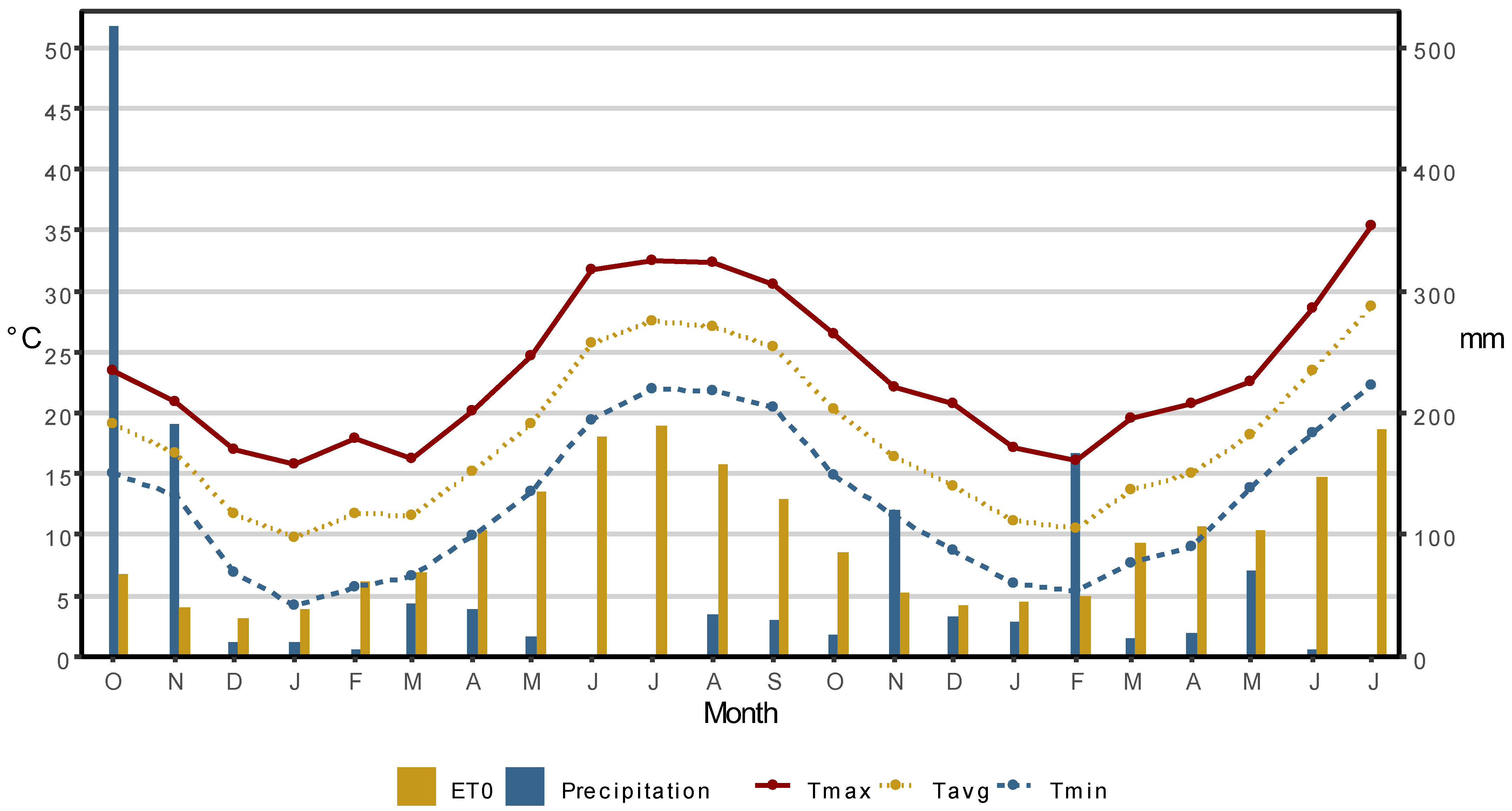


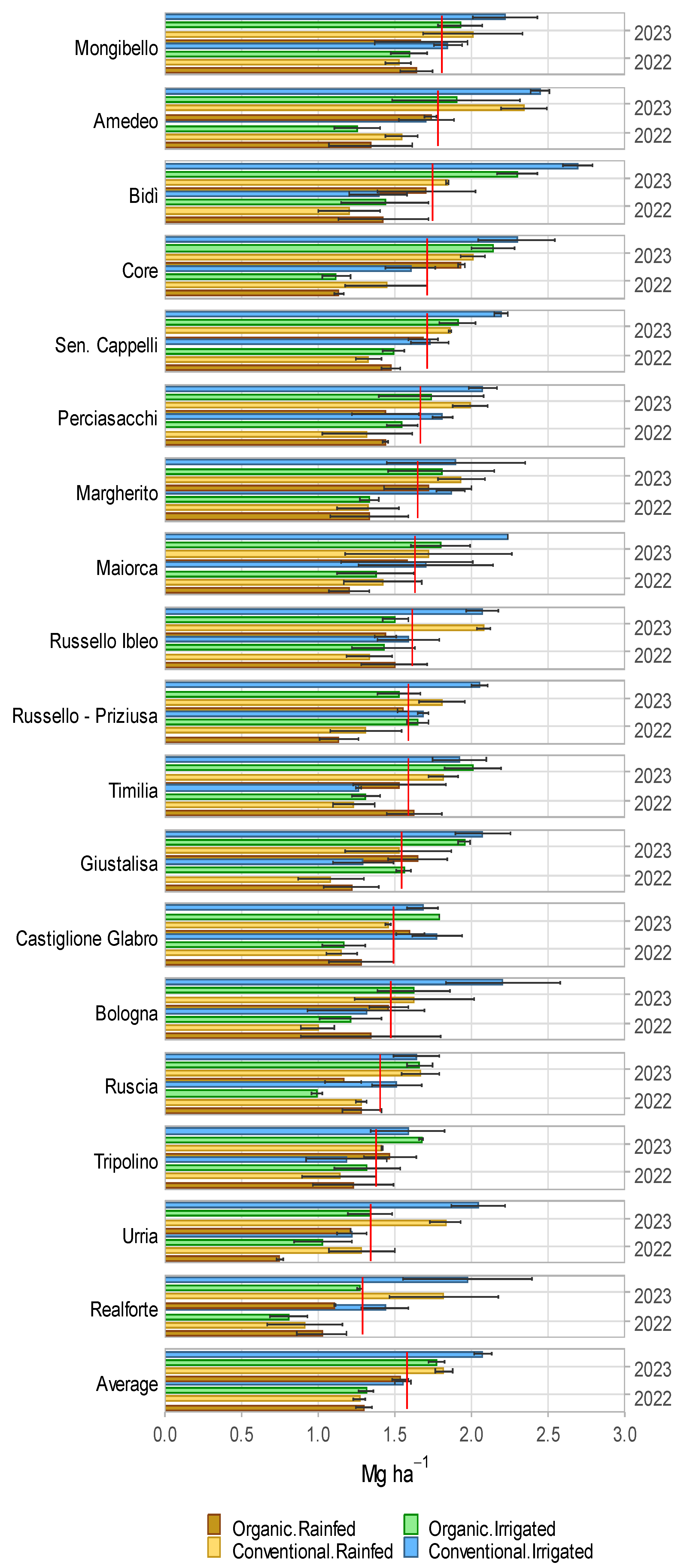
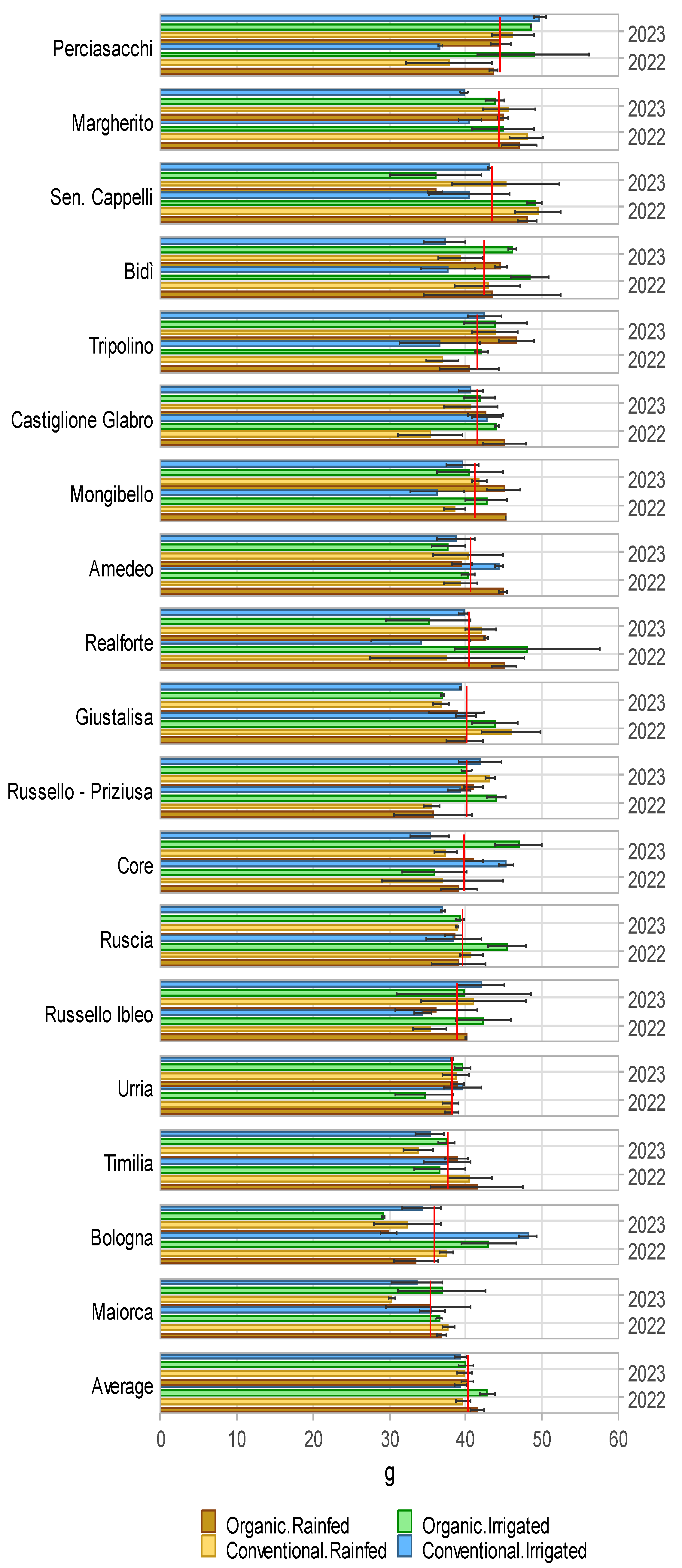
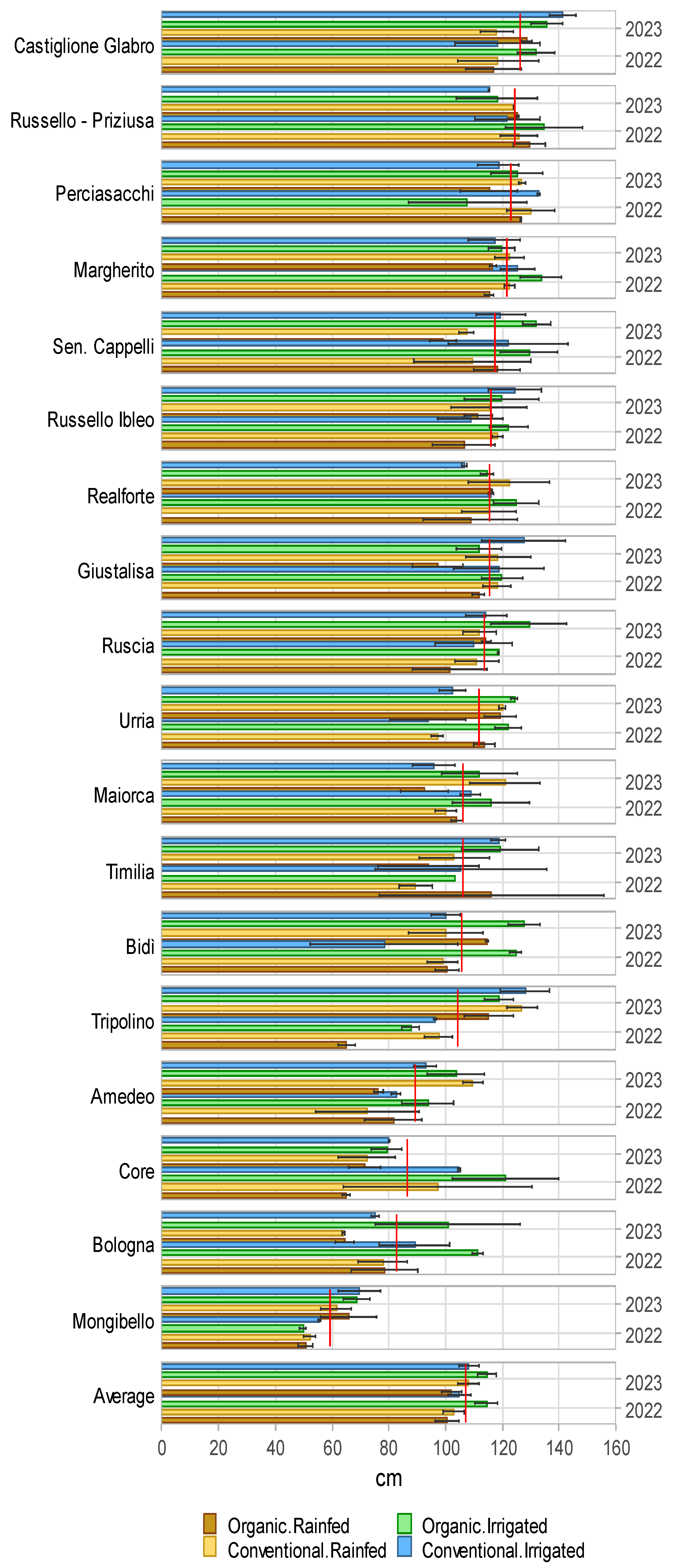
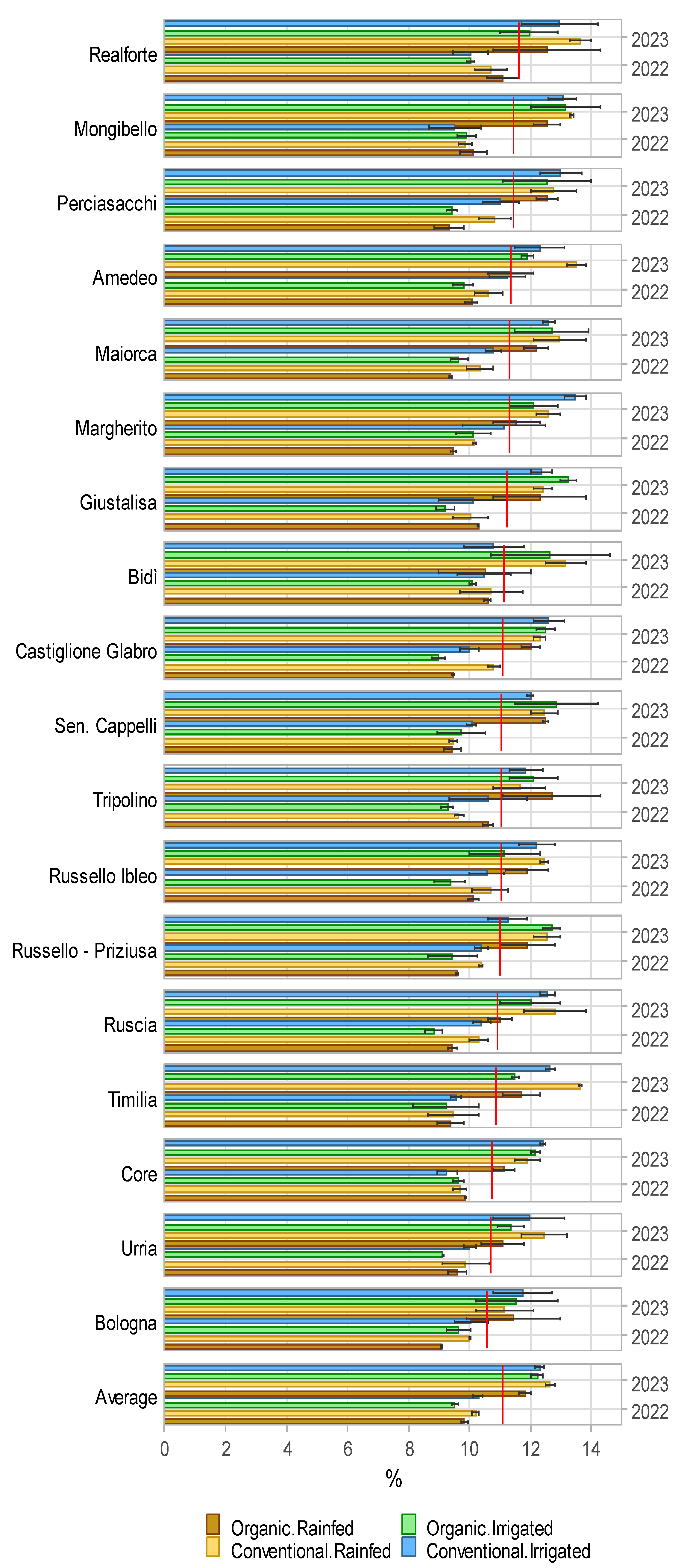

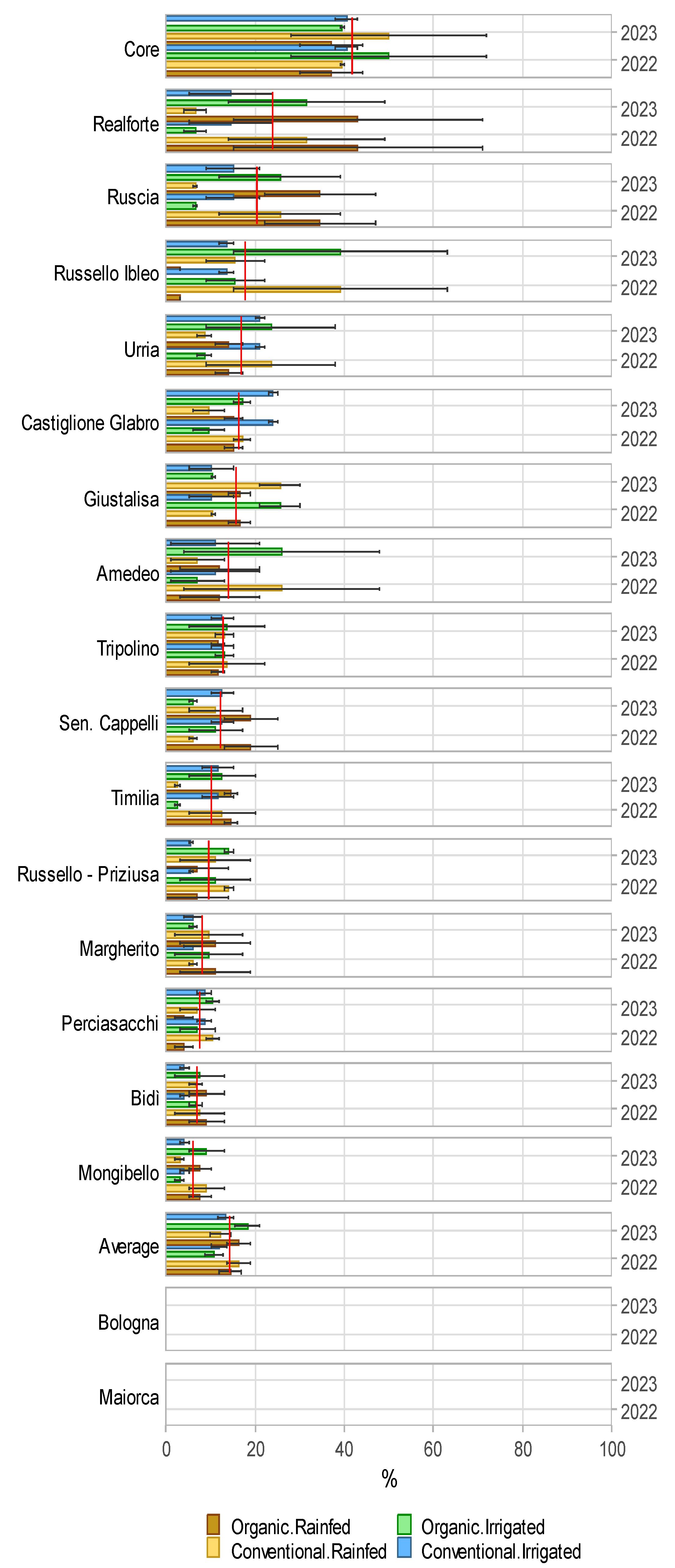
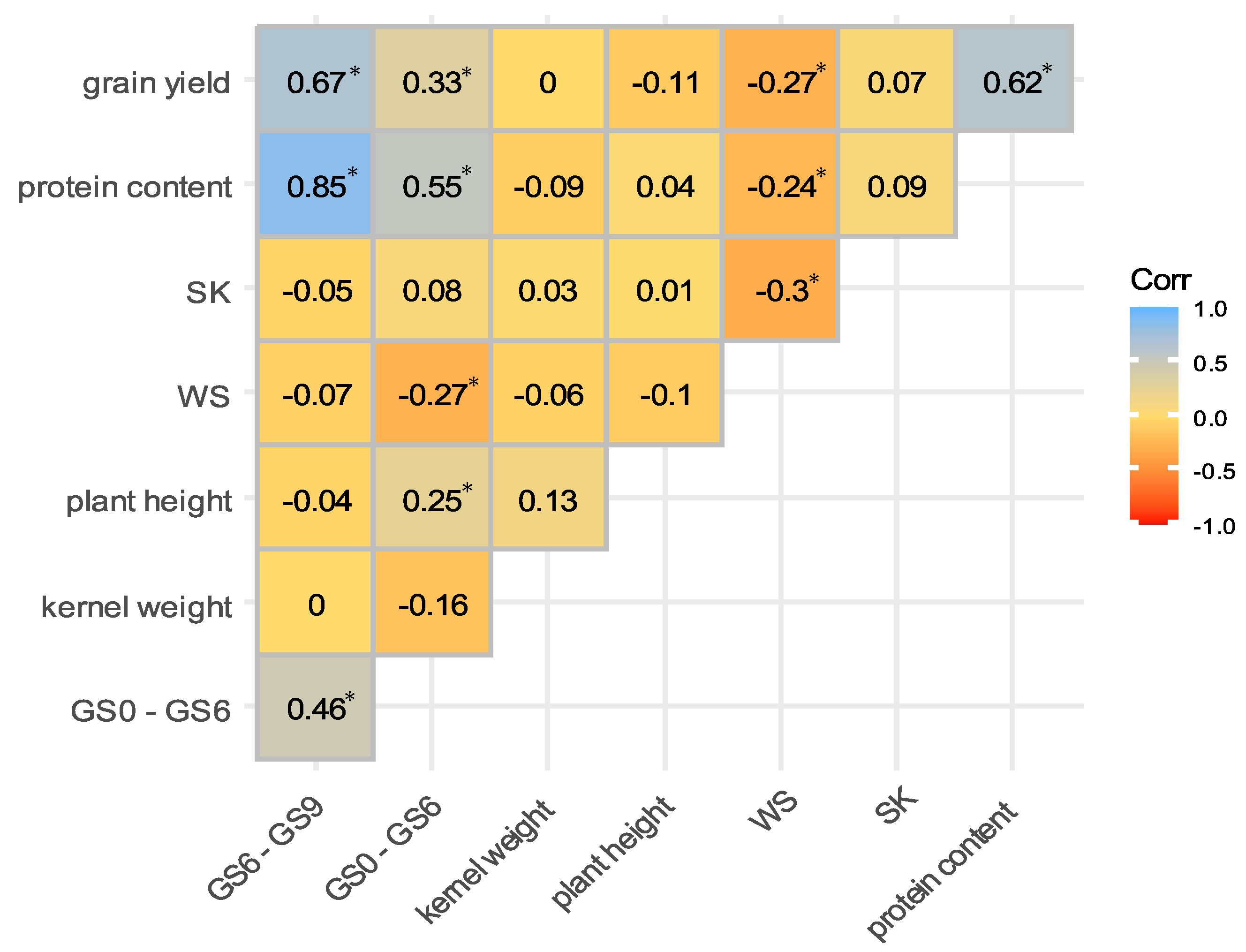
| Soil Characteristics | Unit | 0–25 cm | 25–50 cm | Method |
|---|---|---|---|---|
| Sand | % | 49.3 | 54.6 | Gattorta [37] |
| Loam | % | 22.4 | 11.8 | Gattorta [37] |
| Clay | % | 28.3 | 33.6 | Gattorta [37] |
| pH | 8.6 | 7.7 | In water solution | |
| Total calcareous | % | 15.2 | 13.7 | Gas volumetric [38] |
| Organic matter | % | 1.4 | 1.6 | Walkley and Black [38] |
| Total N | ‰ | 1 | 0.09 | Kjeldahl [38] |
| P2O5 availability | mg kg−1 | 5 | 2.3 | Ferrari [38] |
| K2O availability | mg kg−1 | 245 | 200 | Dirks and Scheffer [38] |
| Bulk density | g cm−3 | 1.1 | 1.35 | |
| Field capacity at −0.03 MPa | % | 27 | 28 | |
| Wilting point at −1.5 MPa | % | 11 | 18 |
| Variable | 2021–2022 Observed Values | 2022–2023 Observed Values | Long-Term Average |
|---|---|---|---|
| Tmax | 21 °C | 20.8 °C | 20.5 °C |
| Tmin | 9.88 °C | 10.03 °C | 10 °C |
| Tavg | 15.3 °C | 15.5 °C | 15.1 °C |
| ET0 | 588 mm | 543.5 mm | 586.8 mm |
| Precipitation October to July | 835 mm | 474 mm | 544.1 mm |
| Precipitation Sowing to Harvesting | 103.6 mm | 303.4 mm | 249 mm |
| Genotypes Name | Origin | Pedigree |
|---|---|---|
| Amedeo | Italy | Maristella × Capeiti [40] |
| Bidì | Italy | Selection from Tunisian landrace [41] |
| Bologna | Italy | (H89092 × H89136) × Soissons [42] |
| Castiglione Glabro | Italy | Indigenous landrace from Sicily [43] |
| Core | Italy | Platani × Gianni [43] |
| Giustalisa | Italy | Indigenous landrace from Sicily [43] |
| Maiorca | Italy | Indigenous landrace from Sicily [44] |
| Margherito | Italy | Selection from Tunisian landrace Mahmoudi [41] |
| Mongibello | Italy | Trinakria × Valforte [45] |
| Perciasacchi | Italy | Indigenous landrace from Sicily [44] |
| Realforte | Italy | Indigenous landrace from Sicily [43] |
| Ruscia | Italy | Indigenous landrace from Sicily [43] |
| Russello Ibleo | Italy | Indigenous landrace from Sicily [44] |
| Russello Priziusa | Italy | Indigenous landrace from Sicily [46] |
| Senatore Cappelli | North African | Strampelli’s selection. North African cultivar derived from Jennah Khetifa [47] |
| Timilia | Italy | Indigenous landrace from Sicily [44] |
| Tripolino | Italy | Indigenous landrace from Sicily [43] |
| Urria | Italy | Indigenous landrace from Sicily [43] |
| Source of Variation | Grain Yield | Protein Content | Plant Height | WS | SK | Seed Weight | S-E | E-PM |
|---|---|---|---|---|---|---|---|---|
| Irrigation | 1.43 × 10−5 | 0.73 | 0.01 | 0.82 | 0.34 | 0.92 | 0.25 | 0.12 |
| Management | 1.01 × 10−5 | 0.003 | 0.34 | 5.28 × 10−7 | 9.05 × 10−2 | 0.004 | 0.01 | 0.02 |
| Genotype | 1.22 × 10−5 | 0.09 | 2.2 × 10−16 | 2.20 × 10−16 | 2.2 × 10−16 | 1.32 × 10−5 | 2.00 × 10−16 | 2.00 × 10−16 |
| Year | 2.20 × 10−16 | 2.20 × 10−16 | 0.22 | 0.001 | 0.24 | 0.08 | 2.00 × 10−16 | 2.00 × 10−16 |
| Irrigation × Management | 0.03 | 0.43 | 0 | 0.68 | 4.90 × 10−6 | 0.36 | 0.83 | 0.05 |
| Irrigation × Genotype | 0.96 | 0.94 | 0.43 | 2.82 × 10−7 | 0.0002473 | 0.41 | 1 | 0.99 |
| Management × Genotype | 0.05 | 0.44 | 0.14 | 8.78 × 10−10 | 2.2 × 10−16 | 0.24 | 0.54 | 0.43 |
| Irrigation × Management × Genotype | 1 | 0.86 | 0.98 | 2.08 × 10−9 | 3.23 × 10−4 | 0.89 | 1 | 0.65 |
| Trait | Irrigation | Management | ||
|---|---|---|---|---|
| Rainfed | Irrigated | Organic | Conventional | |
| Grain yield | 1.48 ± 0.37 | 1.67 ± 0.42 | 1.48 ± 0.35 | 1.68 ± 0.43 |
| Protein content | 11.13 ± 1.44 | 11.09 ± 1.52 | 10.85 ± 1.50 | 11.36 ± 1.41 |
| Plant height | 103.52 ± 23.15 | 111.08 ± 21.30 | 108.10 ± 23.09 | 106.49 ± 22.01 |
| WS | 33.86 ± 12.50 | 34.72 ± 12.10 | 32.50 ± 13.13 | 36.08 ± 11.15 |
| SK | 16.21 ± 12.17 | 16.05 ± 10.04 | 18.36 ± 11.55 | 13.91 ± 10.27 |
| 1000-seed weight | 40.28 ± 5.13 | 40.33 ± 5.27 | 41.10 ± 5.33 | 39.51 ± 4.94 |
| S-E | 108.44 ± 4.43 | 108.06 ± 4.18 | 108.67 ± 4.44 | 107.83 ± 4.14 |
| E-PM | 33.17 ± 9.48 | 33.70 ± 9.88 | 33.01 ± 9.57 | 33.85 ± 9.78 |
Disclaimer/Publisher’s Note: The statements, opinions and data contained in all publications are solely those of the individual author(s) and contributor(s) and not of MDPI and/or the editor(s). MDPI and/or the editor(s) disclaim responsibility for any injury to people or property resulting from any ideas, methods, instructions or products referred to in the content. |
© 2024 by the authors. Licensee MDPI, Basel, Switzerland. This article is an open access article distributed under the terms and conditions of the Creative Commons Attribution (CC BY) license (https://creativecommons.org/licenses/by/4.0/).
Share and Cite
Scandurra, A.; Corinzia, S.A.; Caruso, P.; Cosentino, S.L.; Testa, G. Productivity of Wheat Landraces in Rainfed and Irrigated Conditions under Conventional and Organic Input in a Semiarid Mediterranean Environment. Agronomy 2024, 14, 2338. https://doi.org/10.3390/agronomy14102338
Scandurra A, Corinzia SA, Caruso P, Cosentino SL, Testa G. Productivity of Wheat Landraces in Rainfed and Irrigated Conditions under Conventional and Organic Input in a Semiarid Mediterranean Environment. Agronomy. 2024; 14(10):2338. https://doi.org/10.3390/agronomy14102338
Chicago/Turabian StyleScandurra, Alessio, Sebastiano Andrea Corinzia, Paolo Caruso, Salvatore Luciano Cosentino, and Giorgio Testa. 2024. "Productivity of Wheat Landraces in Rainfed and Irrigated Conditions under Conventional and Organic Input in a Semiarid Mediterranean Environment" Agronomy 14, no. 10: 2338. https://doi.org/10.3390/agronomy14102338







